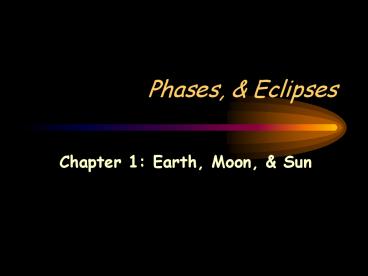Phases, - PowerPoint PPT Presentation
1 / 28
Title:
Phases,
Description:
What is the length of time from a new moon to the next new moon? 29.5 Earth days ... A new moon when the moon becomes directly between the sun and Earth ... – PowerPoint PPT presentation
Number of Views:156
Avg rating:3.0/5.0
Title: Phases,
1
Phases, Eclipses
- Chapter 1 Earth, Moon, Sun
2
Motions of the Moon
3
Why is the day on the moon the same length as a
year on the moon?
- Rotation Day Revolution year
- Since it takes 27.3 Earth days for the moon to
rotate (day) and 27.3 Earth days for the moon to
revolve (year), the day and a year are the same
length
4
Checkpoint How many days does it take the moon
to revolve once around Earth?
- It takes the moon 27.3 Earth days to revolve
around Earth. - It also takes the moon 27.3 Earth days to rotate
5
Phases of the Moon
6
The different shapes of the moon you see from
Earth are called _____.
- phases
7
The moon goes through its whole set of phases
each time it _____ around Earth, or about once a
_____.
- revolves
- month
8
Guide For ReadingWhat causes the phases of the
moon?
- The phases of the moon are caused by the change
of the relative positions of Earth, the moon, and
sun. - Since the moon revolves around Earth we see it
from different angles - The ½ of the moon that faces Earth is not always
the ½ lit up by the sun causing the moons shape
to appear to change - The phase of the moon you see depends on how much
of the sunlit side of the moon faces Earth
9
(No Transcript)
10
What is the length of time from a new moon to the
next new moon?
- 29.5 Earth days
- Since Earth is revolving it takes an extra 2.2
Earth days for the sun, moon and Earth to line
up, causing the next new moon
11
Checkpoint Since the moon does not produce
light, how can you see it?
- Light from the sun reflects off the moon,
enabling it to be seen from Earth.
12
Eclipses
13
Figure 6 Interpreting DiagramsHow large is the
angle between Earths orbit and the moon s
orbit?
- The angle between Earths orbit and the of the
moon is 5º
14
When does an eclipse occur?
- In a rare occasion when the moon or Earth becomes
directly between the sun and the other and cast a
shadow on that object
15
The two types of eclipses are ______ ______.
- lunar
- solar
16
Solar Eclipses
17
Solar Eclipse
- A solar eclipse occurs when the moon comes
directly between the sun and Earth - The moon blocks Earth from sunlight and cast a
shadow - Earths sky becomes darker and you can only see
the corona of the sun
18
(No Transcript)
19
At what phase of the moon could a solar eclipse
occur?
- A new moon when the moon becomes directly between
the sun and Earth
20
The darkest part of the moons shadow is called
the _________.
- Umbra
21
Why are the people in the umbra the only ones
that experience a total solar eclipse?
- The umbra is the darkest part of the of the
moons shadow - People who are in the umbra are in the darkest
part of the shadow where the moon is almost
completely blocking sunlight from reaching Earth,
except for the suns corona
22
Penumbra
- The larger less dark shadow cast by the moon
during a solar eclipse and by Earth during a
lunar eclipse
23
Lunar Eclipses
24
What is a lunar eclipse?
- A lunar eclipse occurs when Earth comes directly
between the sun and moon - Earth blocks the moon from sunlight and cast a
shadow - The moon turns a red/orange color
25
(No Transcript)
26
Figure 8 Interpreting Diagrams What is the
difference between Earths umbra and penumbra?
- The umbra is in the area of total darkness, the
penumbra is the area of partial darkness
27
Checkpoint Why do lunar eclipses occur only at
full moon?
- Earth must come between the sun and the moon
during a lunar eclipse this only happens during
the full moon phase.
28
Guide For Reading What causes solar and lunar
eclipses?
- When the moons shadow hits Earth or Earths
shadow hits the moon, an eclipse occurs. - Eclipses occur when the moons orbit which is
usually tilted becomes not tilted and the sun,
moon and Earth line up perfectly































